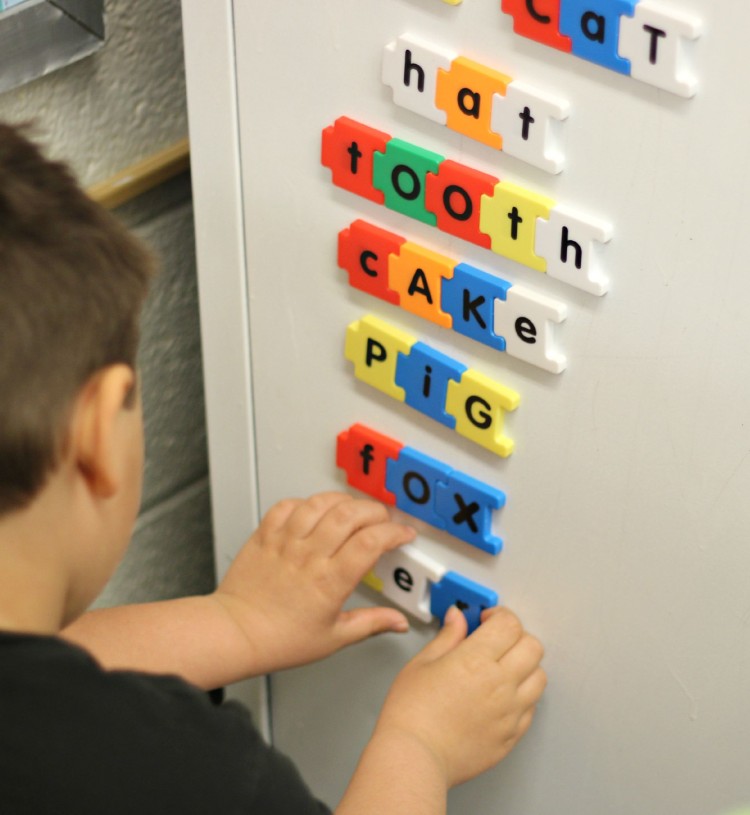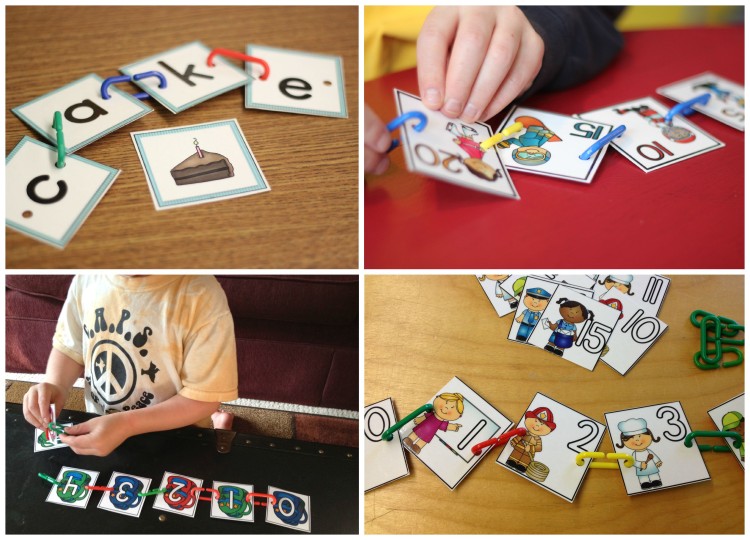Some of our little ones come to our classes without ever having held a pencil, and suddenly, they are expected to show what they know and practice what we teach with grace and fluidity using a pencil. But those little muscles don’t always have it in them to perform that way. It’s why worksheets don’t always belong in a kindergarten class. I know what you’re thinking, ‘But I have standards to meet and a curriculum to present. I don’t have time to build fine motor activities into my schedule.’ You don’t have to build any extra time for fine motor, just use these ideas to meet your standards and provide invaluable experiences building those mighty muscles without ever picking up a pencil. (You’ll find the common core standard in parenthesis after each activity!)
1. Paper Punching Beginning Letter Sounds
Paper punches really stretch those hand muscles. Use paper punches to have students identify beginning sounds. This one has a picture of a dog on the strip of paper. The student uses the paper hole punch to punch out all the letters that do not begin with that sound. The only letters left showing should be the letter ‘d’ in this case. Simple, fun and a quick assessment of letter sounds as well. (RF.K.3A)
If you’d like to get your own copy just complete the email opt in at the end of this post and it will be sent to your email. (Check your spam box!)
2. Lite-Bright Sight Word Practice
A sight word written on a simple piece of paper and placed over the top of a Lite-Brite is a great way to practice words. Punching the jeweled pieces through the paper provides just the right amount of resistance to help strengthen those ever important pincer muscles. This little travel sized Lite-Brite is my favorite, because it doesn’t take up too much space in my classroom. (RF.K.3C)
3. Gak Letter Recognition and Formation
Gak is fun to make and even more fun to use when practicing letter recognition and formation. Call out a letter and have your students work the gak into the letter or letter sound you presented. Even better, have them use scissors to cut up the letter once it is done. The resistance of the gak and scissors is a big muscle builder. (L.K.1A)
4. Word Construction
I’ve seen similar items that were made from real nuts and bolts, but I do love these Word Construction sets from Learning Resources. Used with CVC and CVCC I Can Do It Myself Cards, students build the word as they think it should be spelled and then can independently check their answer. It can also be used for recording real and nonsense words. Twisting, turning and pushing the pieces off and on the bolt is the bonus! (RF.K.2D)
5. Tennis Monster Counting
So perfectly simple. All you need is a tennis ball or two. Students simply roll a die, and feed the tennis monster that many beads. The first student to run out of beads, is the winner. The fine motor part of the game has students pinching the slit tennis ball in order to open the mouth and put the delicious beads inside. It’s great fun, and they REALLY have to work at opening that mouth. (K.CC.B4)
6. Snap Cube Sight Words
Students love snap cubes and the resistance from pushing them together and pulling them apart is so great for their fine motor development. These Snap Cube Sight Word sheets from Jennifer at Simply Kinder are a great addition to any sight word work station. The are also great for appealing to your spatial and kinesthetic learners.(RF.K.3C)
7. Sight Word Pointillism
This activity gives you a great fine motor activity and will be a hit with your artistic/spatial learners. Controlling the q-tip gives students some great strengthening exercise while they practice their sight words. Students should be repeating the word they are dotting each time they make a dot.(RF.K.3C)
8. Magnetic Sight Word Puzzles
These magnetic puzzle pieces have students using their finger dexterity and the magnets give the activity a bit of added resistance. Students build as many words as they can, and then read them to their station partner.(RF.K.3C)
9. Geo Board Numbers (and Letters)
Watch for flying rubber bands. It happens while students are working at producing letters and numbers with geo boards. This one is another popular activity with spatial learners. Pincer muscles have to be pretty strong to keep the rubber bands from flying off the boards’ nobs. The stronger the pincer, the more control they have over the rubber bands. The number cards are from Making Learning Fun. (K.CC.A.3)
10. Paper Punch Sorting and Patterns
Paper punches come in all shapes, sizes and flavors. Letter punches work great for practicing sight words and simple shape punches are a great resource for sorting by color, shape and for building patterns. These kind of punches work the hands a bit differently than the tradition hole punches. Instead of squeezing, your students will be pinching the lever down. (K.MD.B.3)
11. Play-doh Number (and Letter) Mats
Play-doh is a must have in any classroom. You can use letter to practice sight words or number stamps to write math equations or just plain old finger power to manipulate the dough to create letters and numbers. Here students show the number and indicate how it is represented in a tens frame on these Play-doh Math Mats. You can never go wrong with using Play-doh to build finger muscles. (K.CC.A.3, K.CC.B.5)
12. Digging For Nonsense Bones
Tongs work great when digging up real and nonsense words from this dinosaur sensory table. Students could use only their tongs to gently unearth the prehistoric bones and sort them by ‘real’ or ‘nonsense’ status. Pincer muscles had to carefully maneuver the bones out or the colorful sensory sand in order to sort them. (RF.K.2D)
13. Clothespin Rhyming Match Up
Pincer muscles are going to work over-time when students pair up rhyming words and secure them with fun, thematic clothespins. If you’d like to pick up the ladybug rhyming activity, just click HERE on the picture below to grab yours. (RF.K.2A)
14. Pokey Pin Letters, Numbers, Shapes and Sight Words
Thumb tacks are small and holding them securely in order to get them to ‘poke’ through a piece of paper can be a tricky fine motor feat. These pokey pin activities from Mrs. Miner’s Monkey Business provide resources to have students poking letters, numbers, sight words and shapes. It takes great concentration and especially nimble fingers. (RF.K.1D, RF.K.3C)
15. Sight Word (CVC, CVCe, Beginning Letter Sounds, Digraphs and more) Letter Bead Practice
Manipulating beads is great fine motor practice by itself, but combine it with letter beads and you have a fantastic fine motor activity. Letter beads like these can be used to practice beginning letter sounds, sight words, cvc words, digraphs or cvce words. Here’s a tip: Use a pipe cleaner instead of string or yarn for greater control and less frustration for your students. No matter what word work skill you’re working on, you are sure to be able to use this fine motor resource to build muscles and enhance learning. (RF.K.3A, RF.K.2D, RF.K.3C)
16. Linking Numbers, Letters and Words
Plastic links can be used in so many ways to enhance instruction and practice for your students while working those fingers. Number order, count by fives, or spell words all while manipulating the cards and links. (K.CC.A1)
17. Building Shapes
Building of any kind is always a great activity for fine motor, but if you use mini marshmallows and toothpicks, your students’ little pincers will get an extra work out while they practice producing their shapes. (K.G.B.5 and 6)
So you see, you don’t have to sacrifice time away from standards to give your students a fine motor work out. With these activities and many more like it, you can have both.
























I love these ideas. I am always looking for new ideas to implement fine motor activities in my classroom. Thanks for sharing!
You are very welcome.
I would like to get an email when you put up a new post but it’s telling me that email is not supported when I put it in the subscribe box.? Please put me on your list!
That’s very weird. I just went into the email subscribe button and entered your information. You should get a confirmation note soon. Sorry for the trouble.
Marsha
Love these ideas. Going to get tennis balls tomorrow! the travel lite brites do not have very good reviews on Amazon. Have you had any problems with yours?
Nope no problems at all.
M
I also tried to subscribed but am being told the same message as the previous commenter. Can you please help? Thanks.
Thanks for letting me know Nadine. It’s really weird, because I know other people are not having that problem because I get notifications from my email server each day. I went ahead and entered your name and email address without any issues. I wonder if it’s the server you’re using. In anycase, you should be getting a notification to confirm your subscription, then you should be all set. Thanks a bunch.
Marsha
I’ve been enjoying reading your posts all day today! You have so many great ideas that I can’t wait to try! Thanks for sharing 🙂
Awww thanks so much for reading. I’m glad you have found value in it.
Marsha
Do you have a download for the activity cards for #16?
Those cards are actually included in all my math and/or literacy station packets on TpT. You can find them in my store.
Marsha
I love the post, so many great ideas! Are the cards shown for #16 Linking letters, numbers and words for sale at your TPT store, I would love to use them in my classroom?
They are items that I always include in my Math Stations Galore, Word Work Stations Galore and Sensory Table packs. You can find them in my TpT store.
Thanks for asking.
Marsha
The activities below, for instance, will build on your child’s fine motor skills and encourage new ones. As your child’s daily wake of destruction has made perfectly clear, emptying a container requires a lot less precision than filling one.
Great post! I am an occupational therapist and would love to print your article as a resource for some of my teachers. Do you have a print button somewhere that I am missing?
Thanks!
I don’t. I’m so sorry. But if there is anything else I can do let me know.
Marsha
Hi
I really like your fine motor activities and thank you for sharing. I was wondering if your hole/paper punching initial sound sheets are available for download please?
Many thanks
yes if you look at the right hand side of my blog, it’s available for you FREE.
Marsha
Can you tell me where you got the magnetic sight word puzzles? Thanks for all of the creative ideas!
I purchased them on Amazon years ago.
Marsha
I am interested in using magnetic sight word puzzles next year with my class. Where did you find them; I have looked everywhere! Thanks! Great ideas.
I was wondering where to purchase the magnetic puzzle alphabet you use in #8? Thank you.
I purchased them on Amazon but I don’t believe they are in production any longer.
Hello,
I love these ideas! Could I get the recipe for your “GAK” activity?
Thanks Stacy
Oh gosh, I think I just looked it up on pinterest. I think it’s pretty common.
Marsha